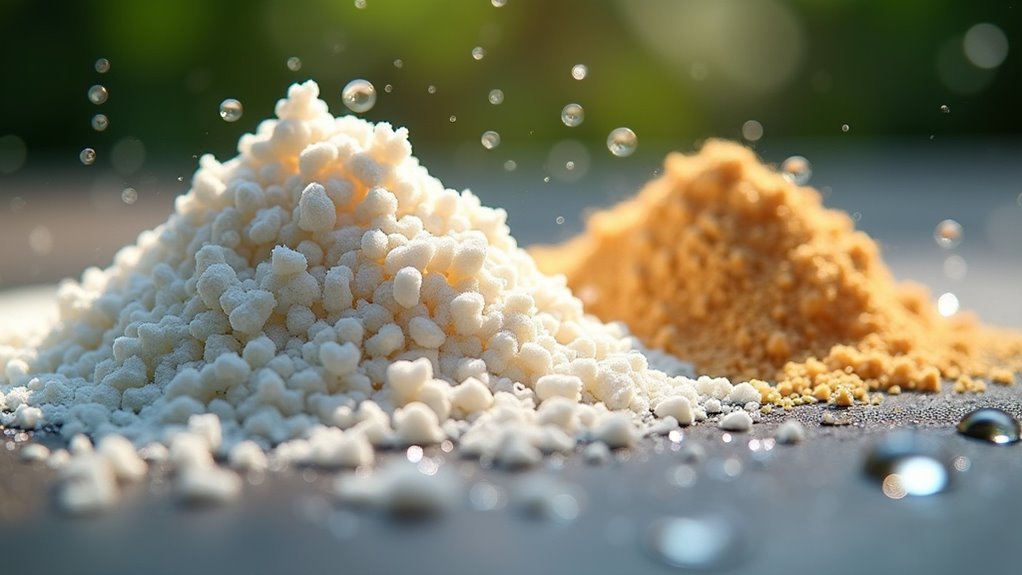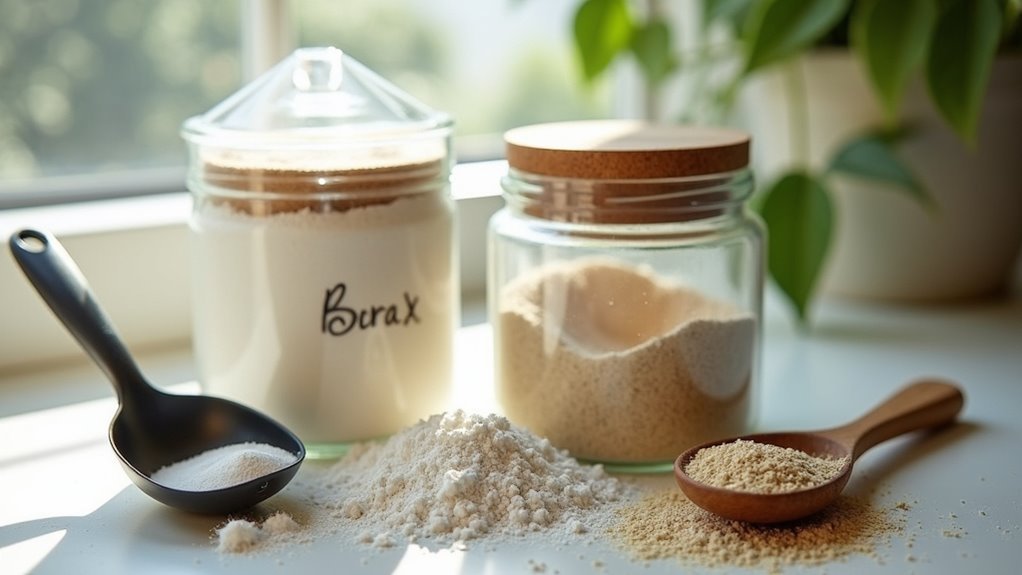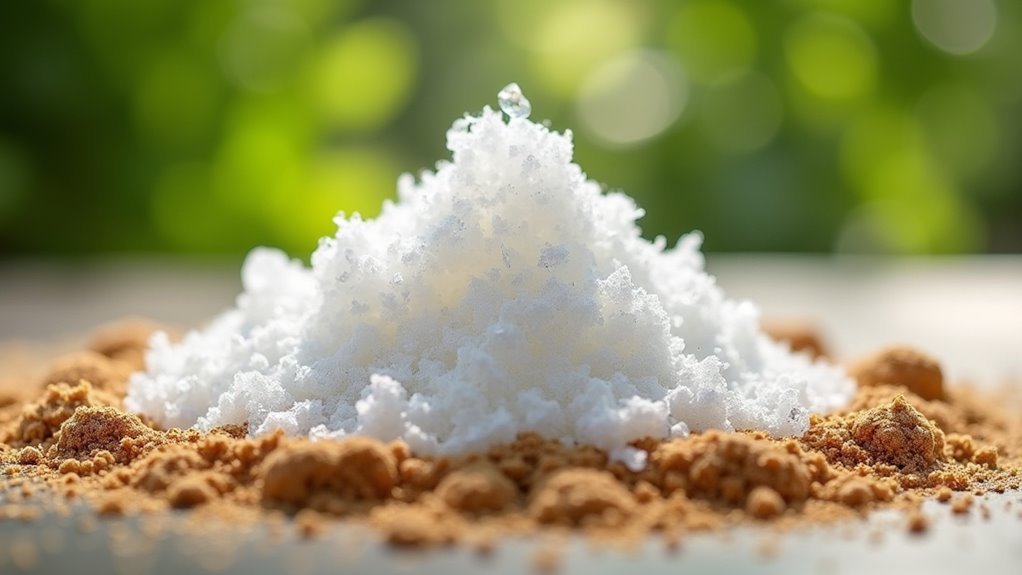You’ll find borax outperforms diatomaceous earth because it eliminates entire ant colonies through ingestion rather than just individual insects on contact. Borax maintains its effectiveness in humid conditions while DE loses potency when wet, and it works faster with results appearing within days. It’s also safer for households since DE can irritate respiratory systems when inhaled. Plus, borax serves multiple purposes as a cleaner and pest control agent. The advantages extend far beyond these initial benefits.
Understanding Borax: Composition and Properties

Borax stands out as a versatile household ally due to its unique chemical composition and natural origins. You’re working with sodium borate, a naturally occurring mineral that combines sodium, boron, oxygen, and water in the formula Na2B4O7·10H2O.
Its white, crystalline structure makes it highly soluble in water, enhancing its effectiveness across multiple applications.
When you use borax for pest control, you’re utilizing its chemical properties as a stomach poison that disrupts insects’ digestive systems and metabolic processes. This leads to dehydration and eventual death upon ingestion.
Unlike mechanical pest control methods, borax’s chemical approach targets insects from within. You’ll appreciate its low toxicity profile for humans and pets when used appropriately, making it a safer choice for household cleaning, laundry, and pest management tasks.
Understanding Diatomaceous Earth: Natural Origins and Structure
You’ll find that diatomaceous earth originates from fossilized diatoms—microscopic algae that lived in ancient aquatic environments over 66 million years ago.
The silica structure within DE consists primarily of opaline silica, creating glass-like properties that give it sharp, abrasive characteristics.
This formation process transformed countless diatom remains into the naturally occurring soft rock deposits you can access today for various applications.
Fossilized Diatom Composition
Millions of years beneath ancient ocean floors, microscopic diatoms lived, died, and accumulated into the remarkable substance we recognize today as diatomaceous earth. These fossilized remains form a powder that’s fundamentally different from boric acid in both composition and effectiveness.
| Component | Diatomaceous Earth | Boric Acid |
|---|---|---|
| Primary Material | Opaline silica from fossilized diatoms | Naturally occurring boron compound |
| Hardness Rating | 8 on Mohs scale (diamond-hard) | 9.3 on Mohs scale |
| Pest Control Action | Cuts insect exoskeletons physically | Disrupts metabolism chemically |
Food-grade diatomaceous earth contains these glass-like particles that damage pests mechanically. While various pest control methods exist, understanding DE’s ancient origins helps explain why many professionals prefer modern alternatives like borax for reliable results.
Silica Structure Properties
When you examine diatomaceous earth under a microscope, you’ll discover an intricate lattice of opaline silica that’s remained virtually unchanged since these marine organisms died millions of years ago.
This glass-like structure creates sharp edges that make diatomaceous earth remarkably abrasive—just two points below diamonds on the Mohs hardness scale. These abrasive properties allow DE particles to physically damage the exoskeletons of insects upon contact, causing dehydration and death.
However, this silica structure presents significant drawbacks. The sharp edges that harm pests can also irritate human respiratory systems when inhaled. Additionally, moisture compromises DE’s effectiveness by causing particles to clump together, reducing their cutting ability and pest control capabilities.
Formation Process Timeline
The remarkable abrasive properties of diatomaceous earth stem directly from its ancient origins, beginning over 66 million years ago when countless microscopic diatoms flourished in Earth’s oceans, lakes, and wetlands. These tiny organisms accumulated on seafloors after death, their fossilized remains compacting into the soft rock we recognize today.
| Timeline Stage | Process | Duration |
|---|---|---|
| 66+ Million Years Ago | Diatom organisms thrive in aquatic environments | Millions of years |
| Death & Settling | Diatom shells accumulate on seafloor/lake beds | Ongoing process |
| Compaction | Pressure transforms remains into soft rock | Geological timescales |
| Modern Processing | Mining and refinement for pest control | Present day |
| Application | Food-grade DE becomes effective pest control alternative to boric acid | Consumer use |
This extensive formation process creates diatomaceous earth’s unique silica structure.
Effectiveness Against Common Household Pests
Although many pest control products flood the market, borax stands out for its proven effectiveness against the most troublesome household invaders.
Borax delivers unmatched results against household pests when countless other products simply fail to eliminate stubborn infestations.
You’ll find it exceptionally effective against ants, cockroaches, and termites, working as a stomach poison that disrupts their digestive systems.
When comparing Boric Acid Vs other treatments, you’ll appreciate its non-repellent properties—pests don’t avoid it, ensuring greater exposure.
Here’s why borax excels as an ant killer and pest control service alternative:
- Versatile Performance: Works in slightly damp environments unlike diatomaceous earth
- Colony Elimination: Mixed with sugar, ants carry it back to eliminate entire populations
- Broad Spectrum: Effective against wider range of household pests
- Environmental Adaptability: Functions in various household conditions where other products fail
You’ll see results within days as targeted pests succumb to its systematic action.
Performance in Moisture-Rich Environments

You’ll find borax maintains its pest-killing power even when humidity levels rise, unlike many alternatives that lose effectiveness in damp conditions.
Its hydroscopic nature actually works to your advantage in moisture-rich environments like basements, bathrooms, and kitchens where other insecticides might fail.
You won’t need to worry about environmental conditions compromising borax’s ability to eliminate ants, cockroaches, and other household pests in these challenging wet settings.
Humidity Resistance Properties
Moisture-rich environments pose a significant challenge for many pest control products, but borax thrives where others fail. Its humidity resistance sets it apart from alternatives like diatomaceous earth, which becomes ineffective when exposed to moisture.
Boric acid maintains its lethal properties regardless of environmental conditions.
You’ll find borax particularly valuable in these moisture-prone locations:
- Kitchens – where steam and spills create humid conditions
- Bathrooms – with constant moisture from showers and sinks
- Crawl spaces – where dampness accumulates naturally
- Behind walls – in areas with condensation buildup
Unlike products requiring dry surfaces, borax continues disrupting insect metabolism even when wet.
This moisture tolerance makes it superior for extensive pest management, allowing you to treat problem areas that other insecticides can’t effectively reach.
Wet Condition Effectiveness
When water saturates your treatment areas, borax’s hygroscopic properties become a distinct advantage.
Unlike diatomaceous earth, which loses effectiveness when moisture clumps its particles together, borax thrives in wet conditions by absorbing surrounding water while maintaining its pest control capabilities.
You’ll find borax continues killing insects by disrupting their digestive systems even in damp basements, humid crawl spaces, or areas with water leaks.
Diatomaceous earth requires completely dry environments to damage insect exoskeletons through its abrasive action.
When wet, DE becomes ineffective and demands frequent reapplication.
Borax’s moisture-absorbing nature actually enhances its attractiveness to ants and other pests, creating an effective lure that works consistently regardless of humidity levels, making it your reliable choice for challenging moisture-rich environments.
Speed of Pest Elimination Results
While diatomaceous earth may show initial results within hours against some pests, borax delivers more thorough and reliable elimination speed across various conditions.
You’ll find that borax’s systematic approach to pest elimination provides superior long-term results compared to diatomaceous earth’s inconsistent performance.
Here’s why borax outperforms in speed:
- Colony destruction: Borax eliminates entire ant colonies within weeks through stomach poisoning.
- Weather independence: Maintains effectiveness regardless of humidity or moisture levels.
- Non-repellent action: Pests don’t avoid borax, guaranteeing maximum ingestion and faster results.
- Baiting advantage: Mixed with attractants, borax draws pests directly to the poison.
Unlike diatomaceous earth’s mechanical action that depends on dry conditions, borax’s chemical properties guarantee consistent speed across environments, making it your most reliable choice for efficient pest elimination.
Application Methods and Ease of Use

Application simplicity makes borax the superior choice for homeowners seeking hassle-free pest control.
You’ll find borax application methods remarkably straightforward – simply sprinkle the powder in targeted areas or mix it with sugary bait to attract ants. This ease of use extends to various locations throughout your home without complex preparation.
Unlike diatomaceous earth, which requires careful placement to avoid moisture, borax maintains its effectiveness even in slightly damp environments.
You won’t need to worry about frequent reapplications since borax remains potent for extended periods. Diatomaceous earth often requires replacement after moisture exposure, creating additional maintenance work.
Borax’s versatility against multiple pests, including cockroaches and termites, means you’re using one product for extensive control rather than switching between different treatments for various insects.
Cost-Effectiveness and Long-Term Value
Because budget considerations drive most homeowners’ pest control decisions, borax delivers exceptional value that outperforms diatomaceous earth in both upfront costs and long-term savings.
You’ll find borax’s cost-effectiveness immediately apparent when comparing prices per application. This budget-friendly solution offers considerably more pest control coverage for your dollar.
Here’s why borax maximizes your investment:
- Bulk availability – Purchase larger quantities at lower per-unit costs
- Multi-purpose functionality – Works as insecticide, cleaner, and laundry booster
- Extended effectiveness – Remains active in enclosed spaces without frequent reapplication
- Colony elimination – Destroys entire ant populations through strategic baiting
The long-term value becomes even more compelling when you consider borax’s moisture resistance.
While diatomaceous earth loses effectiveness in damp conditions, borax continues working, ensuring your pest control investment pays dividends over time.
Safety Considerations for Households With Pets
Pet safety considerations shouldn’t prevent you from choosing effective pest control, and borax offers distinct advantages over diatomaceous earth when protecting your furry family members.
Unlike diatomaceous earth, which creates respiratory irritation through dust clouds, borax won’t compromise your pets’ breathing when properly applied. The abrasive nature of diatomaceous earth causes skin and eye irritation, while borax poses minimal external tissue risks.
You’ll find that boric acid concentrations can be controlled in targeted bait formulations, reducing accidental ingestion risks compared to diatomaceous earth’s widespread application requirements.
Borax’s effectiveness against ants and cockroaches doesn’t require creating airborne particles that threaten pets’ respiratory systems. By storing borax securely and monitoring treated areas, you’ll maintain effective pest control while prioritizing your pets’ wellbeing.
Environmental Impact and Sustainability
When you’re considering pest control options, you’ll want to examine how your choice affects the planet’s health.
Borax’s naturally occurring mineral composition requires less energy-intensive processing than diatomaceous earth, resulting in a smaller carbon footprint from extraction to application.
You’ll also find that borax breaks down more readily in the environment without leaving persistent residues that can accumulate over time.
Carbon Footprint Comparison
As environmental consciousness grows among consumers, borax stands out as the more sustainable pest control option when you compare carbon footprints.
The extraction and processing differences between these materials reveal significant environmental impacts you should consider.
Here’s why borax offers a lower carbon footprint than diatomaceous earth:
- Simpler extraction methods – Borax uses evaporation from saline lakes versus energy-intensive mining of fossilized remains.
- Reduced transportation emissions – More abundant and accessible deposits mean shorter shipping distances.
- Less ecosystem disruption – Mining operations require less extensive land use and environmental disturbance.
- Lower processing requirements – Minimal refining compared to diatomaceous earth’s complex preparation methods.
When you’re making a sustainable choice for pest control, borax’s environmental advantages make it the clear winner for eco-conscious consumers.
Biodegradability and Persistence
Beyond carbon footprint considerations, you’ll find that borax’s natural biodegradability sets it apart as an environmentally responsible pest control solution.
Unlike synthetic pesticides that linger in ecosystems, borax breaks down into natural components without leaving harmful residues. This biodegradable quality guarantees you’re not contributing to soil or water contamination over time.
Borax’s persistence in pest control applications gives you reliable, long-lasting protection even in damp conditions, while maintaining its low toxicity profile.
You won’t face the bioaccumulation issues associated with harsher chemicals. By choosing this eco-friendly alternative, you’re actively reducing your reliance on synthetic pesticides that threaten beneficial insects and wildlife.
This sustainable approach creates healthier living environments while effectively managing pest problems.
Storage and Shelf Life Advantages
One significant advantage of borax lies in its exceptional storage characteristics and extended shelf life.
Borax’s remarkable storage stability and longevity make it an exceptionally practical choice for effective long-term pest control solutions.
When you’re investing in pest control solutions, you’ll appreciate borax’s superior longevity compared to diatomaceous earth. While diatomaceous earth loses effectiveness when exposed to moisture, borax maintains its insecticidal properties even in humid conditions.
Here’s why borax excels in storage:
- Extended shelf life – Remains effective for years when stored properly in cool, dry places
- Environmental resilience – Less sensitive to temperature and humidity fluctuations than diatomaceous earth
- Easy handling – Solid form prevents dust dispersal issues common with diatomaceous earth
- Simple storage requirements – Sealed containers prevent clumping while maintaining effectiveness
You’ll find borax’s stability makes it a more reliable, cost-effective choice for long-term pest management.
Targeted Pest Control Capabilities
Borax’s chemical composition as sodium borate gives you a powerful advantage in pest elimination through its targeted action mechanisms.
You’ll find that Borax works as a stomach poison, disrupting digestive systems in ants, cockroaches, and termites when they consume it. This targeted approach proves more effective than mechanical damage methods since it systematically eliminates entire colonies rather than individual insects.
When you mix Borax with attractive baits, you create strategic pest control solutions that reach hidden areas where other treatments can’t penetrate.
The compound’s hydroscopic properties maintain effectiveness even in humid conditions, ensuring consistent results regardless of moisture levels.
You’re getting thorough pest control that targets multiple species simultaneously, making Borax an efficient choice for addressing various infestations with a single, well-designed application strategy.
Frequently Asked Questions
What Works Better, Diatomaceous Earth or Borax?
You’ll find diatomaceous earth works faster, killing insects within hours through dehydration, while borax takes weeks but remains effective in damp conditions. For quick results, choose diatomaceous earth; for persistent problems, use borax.
Why Do Exterminators Not Use Diatomaceous Earth?
Exterminators don’t use diatomaceous earth because you’ll face slow kill times, moisture sensitivity issues, difficult application requirements, and potential respiratory hazards that make chemical alternatives like boric acid more reliable and efficient.
Should I Use Boric Acid or Diatomaceous Earth?
You should choose boric acid for long-lasting control in damp areas and severe infestations. Use diatomaceous earth if you’ve got pets, children, or need immediate results in dry conditions.
Is Borax or Diatomaceous Earth Better for Fleas?
You’ll find borax more effective for fleas since it kills them faster within days by disrupting their digestive systems. It’s also more potent indoors and works better in damp conditions than diatomaceous earth.
In Summary
You’ll find borax offers faster pest elimination and better performance in humid conditions compared to diatomaceous earth. While DE’s natural composition appeals to eco-conscious users, borax provides more targeted control against specific pests like ants and cockroaches. However, you’ll need to exercise greater caution with borax around pets and children. Consider your specific pest problem, household safety requirements, and environmental priorities when making your choice between these two effective pest control options.





Leave a Reply